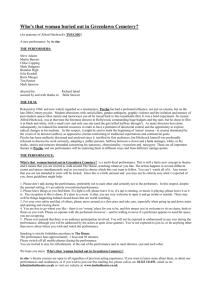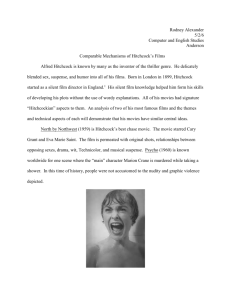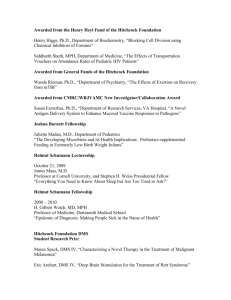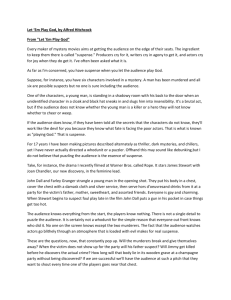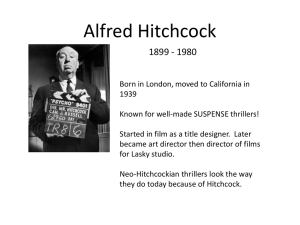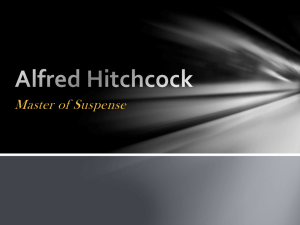Yael Averbuch English and Computers Due: April 11, 2006 The
advertisement
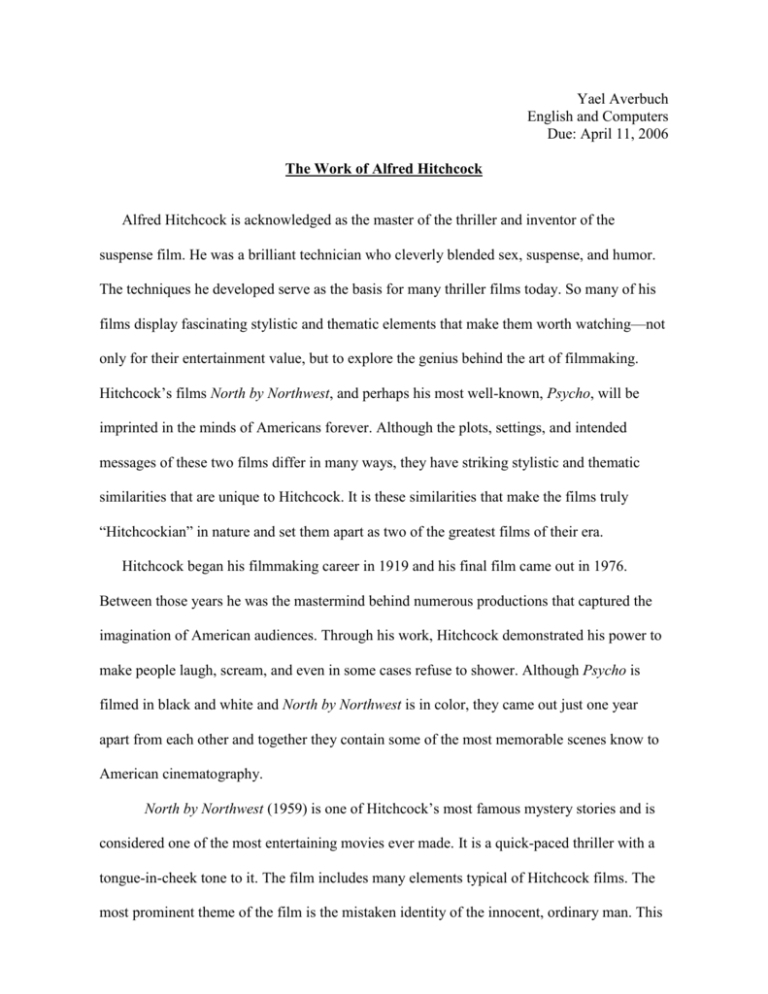
Yael Averbuch English and Computers Due: April 11, 2006 The Work of Alfred Hitchcock Alfred Hitchcock is acknowledged as the master of the thriller and inventor of the suspense film. He was a brilliant technician who cleverly blended sex, suspense, and humor. The techniques he developed serve as the basis for many thriller films today. So many of his films display fascinating stylistic and thematic elements that make them worth watching—not only for their entertainment value, but to explore the genius behind the art of filmmaking. Hitchcock’s films North by Northwest, and perhaps his most well-known, Psycho, will be imprinted in the minds of Americans forever. Although the plots, settings, and intended messages of these two films differ in many ways, they have striking stylistic and thematic similarities that are unique to Hitchcock. It is these similarities that make the films truly “Hitchcockian” in nature and set them apart as two of the greatest films of their era. Hitchcock began his filmmaking career in 1919 and his final film came out in 1976. Between those years he was the mastermind behind numerous productions that captured the imagination of American audiences. Through his work, Hitchcock demonstrated his power to make people laugh, scream, and even in some cases refuse to shower. Although Psycho is filmed in black and white and North by Northwest is in color, they came out just one year apart from each other and together they contain some of the most memorable scenes know to American cinematography. North by Northwest (1959) is one of Hitchcock’s most famous mystery stories and is considered one of the most entertaining movies ever made. It is a quick-paced thriller with a tongue-in-cheek tone to it. The film includes many elements typical of Hitchcock films. The most prominent theme of the film is the mistaken identity of the innocent, ordinary man. This character is often referred to as the “Wrong Man” hero. In North by Northwest this character is Thornhill, a man who is normally sheltered by his wealth and prestige, but who is suddenly made vulnerable, isolated, and involved in an unexplainable series of events. Psycho (1960) is just as quick-paced and shares the same element of mystery. However, its tone and themes differ. Psycho is a complex, psychological thriller. Often referred to as the “mother” of all horror films, its themes include corruption, confused identities, human victimization, vulnerability, and the deadly effects of money. The film broke conventions in several ways, most importantly in the fact that Marion Crane, the protagonist, was surprisingly killed only a third of the way into the story. In addition, the showing of Marion in only her undergarments and also the flushing of a toilet in a film were unprecedented. Despite the gory story line, there are only about two minutes of actual violence present. The remainder of the horror and suspense is merely created in the mind of the audience. Unlike North by Northwest, the plot of Psycho is not extraordinary. Its true cleverness lies in its construction. Psycho is so layered and complex that it is impossible to catch all of its subtleties in only one viewing. Much more so than in North by Northwest, there is symbolic imagery pervasive in Psycho. For example, the images of birds and mirrors are ever-present in the film. These are only two examples of repeating images throughout the film, but Hitchcock made use of many others. Hitchcock was also a master of making use of surprises and hidden information. In both films, information is hidden from the characters and the audience, which adds to the suspense and enhances interest in the plot. In Psycho, there are two main surprises—the shower scene and the final revelation about Mother. In North by Northwest, information about the mysterious character George Kaplan is revealed to the audience only as Thornhill discovers it himself. Also, it is unclear for the majority of the movie if Eve Kendall is trying to help Thornhill or harm him. By revealing such information slowly as the film progresses, Hitchcock is able to maintain interest in his plots. Hitchcock also makes use of something called a MacGuffin device in both North by Northwest and Psycho. A MacGuffin is a plot device used in film, especially thrillers, that holds no meaning of its own except to drive the plot and as motivation for the characters. The term was actually invented by Hitchcock himself and is generally used only in reference to his plots. In North by Northwest the MacGuffin is the character George Kaplan. His purpose is solely to generate interest and to serve as incentive for all the characters to carry out their actions. Likewise, in Psycho, the $40,000 stolen from the realtor’s office is the MacGuffin. Elements independent of Hitchcock’s plots also play major roles in his films. A great example is the background music in both North by Northwest and Psycho. In both films, Hitchcock collaborated with composer Bernard Herrmann to produce some of the most memorable moments in film history. Herrmann responded to the quick pace of North by Northwest by using Latin American rhythms. Sometimes they are even off-key and seem to race along, almost pushing the characters and the plot with them. There are specific scores for the love scenes as well that are difficult to explain through words but have a distinct feel to them that any viewer will immediately recognize. In Psycho, Herrmann’s contribution is shrill, discordant music that becomes the signature suspense tune. It has been used in countless other films to denote the appearance of a “psycho.” Perhaps the most recognizable is the shrieking violin music played during the stabbing scenes. In addition to music, the opening scenes of both the films play a very important part in setting the stage. Psycho begins by showing the credits with abstract gray horizontal and vertical lines streaking back and forth, violently splitting apart the screen. These patterns can be correlated to the split, schizophrenic personality of Norman Bates. North by Northwest immediately establishes the crowded, chaotic environment in which Thornhill finds himself. It begins with a pale green screen on which grid lines appear to make it almost resemble graph paper. This is soon transformed into the side of a skyscraper displaying reflections of a busy midtown Manhattan street during rush hour. As each film progresses, specific scenes are very memorable and can be considered typical of Hitchcock’s unique style. One example from North by Northwest is occurs during the seven-minute scene that takes place near a Midwest cornfield. It is framed much like a classic western, especially the quick shot of Thornhill standing opposite the man waiting for the bus, as he tries to decide if the man is, in fact, Kaplan. Unquestionably the most famous scene from Psycho is the shower scene. As Marion showers, she is brutally stabbed to death as the audience watches in terror as her blood oozes down the shower drain. The viewer does not actually sees Marion being stabbed, but instead is bombarded with the disturbing images of her facial expressions as it happens. Both of these scenes display Hitchcock’s genius in depicting suspense, although in two completely different scenarios. While North by Northwest and Psycho are very different films, each with their unique themes and plots, Hitchcock’s traditional style is apparent in both. They are both quick-paced thrillers with complex plots, often including many subtleties and surprises. These two films, and many others like them, are what gave Hitchcock his well-deserved title as the Master of Suspense. North by Northwest. Dir. Alfred Hitchcock. Universal. 1959. Psycho. Dir. Alfred Hitchcock. Universal. 1960.


